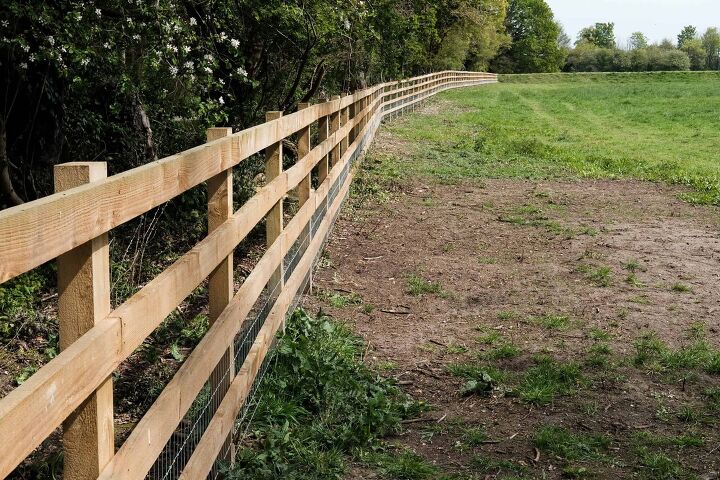Is 2 Feet Deep Enough for Fence Posts? (Find Out Now!)

Building a fence is a great way to add some added privacy to your home. If you live in a rural area, you can also use a fence to create a pasture for all your pets. It’s essential to know how to build a fence properly to ensure it’s durability.
You can install fence posts with holes that are 2 feet deep, and that is the minimum depth. However, you need to dig deeper holes if the fence post is 7 feet or larger. Dig holes with a depth that measures at least ½ of the size of the fence post.
Because so much goes into building a sturdy fence, I wanted to share with you the proper way to do so. Below we’ll discuss everything you need to know to make the fence of your dreams. This includes everything from how to keep it secure to which side should be facing your neighbors.
Do You Need Fence Installation or Repair Services?
Get free, zero-commitment quotes from pro contractors near you.

Essential Tools and Materials
For this article, we’re going to assume you’re building a 6-foot-tall fence. Posts lengths generally start around eight or 10 feet for a fence of this height. They’re most commonly four-by-fours, which measure approximately 3 ½’’ by 3 ½’’ around.
You could also use six-by-sixes that are 5 ½’’ by 5 ½’’ around. While these dimensions are standard, it can vary from one piece of lumber to another. The average panel height on a privacy fence is six feet, and the panel length is eight feet.
Post holes can be made using a digger and a shovel. Some folks also opt for using a power auger to get the job done quicker. All in all, here’s what you’ll need for the average privacy fence:
- Posts
- Panels
- Shovel or auger
- Cement
- Tape measure
I know how confusing it can be to find the right products for your project. Later on, we’ll compare how much all the tools and materials are at the top three hardware stores. In the meantime, you may want to make a budget for your fence.
How Deep Should Fence Posts Be?
The first thing you need to do before you ever pick up a shovel is call 8-1-1. This is the national call-before-you-dig hotline that will tell you how deep you can dig in your yard. There are underground utility and communication lines that you need to know about.
If you end up digging before calling that number, you could hit one of these lines or wires. Doing so can result in extremely painful injuries that could result in death. It takes just a few minutes to follow this safety precaution and will ensure you won’t hit any lines.
Speaking of safety, while building a fence, it’s good to wear thick gloves to avoid splinters. When mixing concrete, you may also want to use goggles and a mask to steer clear of unpleasant fumes.
Panel Post Depth
The minimum depth that a post hole should be for a panel section is two feet. A general rule used when building a fence is to dig the holes ⅓ to ½ of the post’s aboveground height.
The more of the post that is underground, the more sturdy and durable the fence will be once completed. It’s also common for some to use eight-foot posts and bury them two feet into the concrete. If you do this, you can trim the tops of the lumber to a final desired height after they’re installed.
Width Guidelines
Something that homeowners can often forget is the importance of how wide the post holes are. The width of these holes should be at least 10 inches wide if you’re using four-by-four posts.
This is a must if you’re filling the holes with concrete. If you’re backfilling with soil and gravel, you can get away with an eight-inch diameter. An easy rule of thumb to follow is to make the hole three times wider than the post’s width.
Getting Concrete Ready
When buying concrete to secure fence posts, go with a standard gravel mix. You have the option of buying dry concrete by the bag or get a truck to deliver ready-to-pour concrete.
Bagged concrete comes in both 40 and 60-pound bags. Don’t underestimate how much of this stuff you’ll need for an entire fence. For each hole of a four-by-four post, you’ll need nearly four bags of 40-pound concrete.
If you’re using six-by-six posts, you’ll save money by purchasing the bigger bags of concrete. Experts suggest overfilling the holes slightly and creating a dome to keep water from getting inside.
What About Gates?
If you’re adding a gate onto your fence, you may be wondering if the measurements are the same. The minimum depth for gate posts is 32 inches, especially if there’s a gap under the gate door. Gates are often heavier, resulting in the need for extra stability.
Not digging deep enough will cause the gate to loosen the posts closest to where the entrance is located. Eventually, they could lean or break off entirely if not appropriately secured. If you have them cemented into the soil, this can be difficult to repair.
Fence Pricing
As of 2020, the average American yard has 150 linear feet of home fencing. If you’re using wood, this can cost you around $2,500. Building a fence can fall anywhere between $1,600 and $4,000 to build.
While the exact pricing may vary, you can expect to pay between $13 to $50 per linear foot of fencing. This includes the cost of materials and labor. If you do it yourself, you can plan on paying much less.
To plan your budget, we’re going to create a hardware store comparison chart. You can use the one below or create one for the stores nearest you. For this example, we’re going to go with a six-foot-tall, 150-foot-long fence that has four corners and has posts spaced five-feet-apart.
| Product | Menards | Home Depot | Lowes |
| 20 4×4 posts | $480 | $300 | $400 |
| 20 6×6 posts | $1,000 | $900 | $700 |
| 40-pound bag of concrete | n/a | $280 | $240 |
| 60-pound bag of concrete | $216 | $198 | $288 |
This includes the correct amount of concrete for the entire fence. If you’re comparing local prices, you’d need roughly 80 40-pound bags or 60 60-pound bags.
Do You Need Fence Installation or Repair Services?
Get free, zero-commitment quotes from pro contractors near you.

Related Questions
There are several options when it comes to how to secure the fence posts. The best one to use is concrete. It easily sets the posts, especially if you’re pouring it onto sandy soil. Gravel could work as well if you have clay-like soil around the area.
Should I use 4×4 or 6×6 fence posts?While you can use whatever size posts you’d like for your fence, it’s best to go with six-by-six posts. They do cost a bit more, but it will make a huge difference in the durability of your fence. Shorter posts can distort due to weather and aren’t easy to replace.
Something to keep in mind about using larger posts is they require a deeper hole. In addition, this will also require more concrete. As I said, it will end up costing you more but it’s well worth it for a fence that will last a lifetime.
How tall can you make a privacy fence?Depending on where you live, there may be guidelines to follow. If you don’t have any script HOA rules and regulations, the choice is up to you. Most privacy fences tend to fall between six and eight feet tall.
This can help to slightly block the view your nosy neighbor might have. If you have a large dog or outdoor cat that loves to jump over fences, you could even build taller.

Kirstin is a passionate writer who loves helping people learn new things when it comes to home improvement. When she's not behind a keyboard, she enjoys DIY projects, crafts, spending time with her pets, and making videos. She hopes that with all she writes, someone is finding a solution to their home improvement needs.
More by Kirstin Harrington

























![10 Most Dangerous Neighborhoods in Baltimore [Updated]](https://cdn-fastly.upgradedhome.com/media/2023/07/31/9075655/10-most-dangerous-neighborhoods-in-baltimore-updated.jpg?size=350x220)

